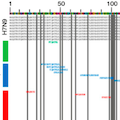Abstract
The absence of preexisting neutralizing antibodies specific for the novel A (H7N9) influenza virus indicates a lack of prior human exposure. As influenza A virus–specific CD8+ T lymphocytes (CTLs) can be broadly cross-reactive, we tested whether immunogenic peptides derived from H7N9 might be recognized by memory CTLs established following infection with other influenza strains. Prob- ing across multiple ethnicities, we identified 32 conserved epitopes derived from the nucleoprotein (NP) and matrix-1 (M1) proteins. These NP and M1 peptides are presented by HLAs prevalent in 16–57% of individuals. Remarkably, some HLA alleles (A0201, A0301, B5701, B1801, and B0801) elicit robust CTL responses against any human influenza A virus, including H7N9, whereas ethnicities where HLA-A0101, A6801, B1501, and A*2402 are prominent, show limited CTL response profiles. By this criterion, some groups, especially the Alaskan and Australian Indigenous peoples, would be particularly vulnerable to H7N9 infection. This dissection of CTL-mediated immunity to H7N9 thus suggests strategies for both vaccine delivery and development.
Significance
The severity of the novel H7N9 influenza A virus (IAV) and the lack of neutralizing antibodies raise real pandemic concerns. In this scenario, CD8+ T lymphocytes (CTLs) may provide a layer of protection against the H7N9 virus. Our study dissects the extent of preexisting CTL immunity with the potential to respond to H7N9. We identified conserved immunogenic peptides with the capacity to elicit robust CTL responses against any human IAV, including the H7N9 virus, as well as the mutations that abolish CTL recognition. The human leukocyte antigen class I molecules that present these peptides vary in prevalence depending on the ethnicity. Such analyses found that the Alaskan and Australian Indigenous people may be particularly vulnerable to the H7N9 influenza disease.
